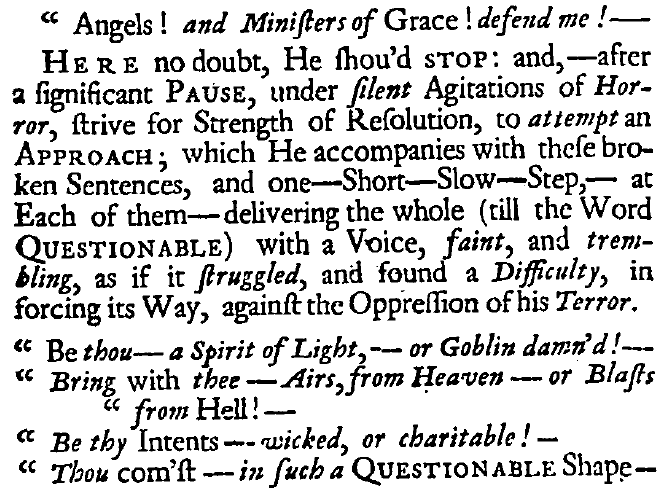Inside the cover of my book, you will find five black-and-white images. They are:
- A page from James Burgh’s Art of Speaking (1761), which shows how he marked up the passions to be found in a conversation between Shylock and Tubal.
- Two images showing Richard Steele’s attempts in 1775 to write down exactly how Hamlet’s ‘To be or not to be’ soliloquy was pronounced: one in the style of a ranting actor, and one as Garrick did it.
- A page from a 1753 edition of Nahum Tate’s King Lear, which bears annotations from Garrick and others indicating their thinking about how to stage the tragedy’s storm scenes.
- And, finally, a page from a first edition copy of William Richardson’s A Philosophical Analysis and Illustration of Some of Shakespeare’s Remarkable Characters (1774).
Each of these images allow my readers to see how critics of the past thought about theatrical transition, how they identified it and used it as an interpretative tool. Burgh’s book makes clear the need for transitions between the wildly different passions he identifies in Shylock’s speech; Steele’s ranting actor has no musicality in his delivery, while Steele’s Garrick makes use of anacrusis to capture the shifts in Hamlet’s thoughts; the annotated Lear shows how theatrical special effects were keyed to transitions in the mad kind’s speeches; and Richardson’s printed analysis splits up his quotation of characters’ speeches as a way of marking transitions in those speeches.
As I write about these images, I’m struck by how bookish they are. Other volumes that are interested in actors have lots of pictures of actors in them. I don’t. Apart from the obvious limitations of cost, there are two other reasons for this. First, and as much better critics than I have already demonstrated, pictures of actors are dangerous, complicated sources, and need to be handled with extreme care. Only occasionally do they answer the questions I am asking in this book, and so I only occasionally refer to them. The second reason takes me to my book’s title, where the ordering of terms is not just euphonic: Criticism, Performance, and the Passions is mainly about criticism in the eighteenth century, and what we can learn from it. The traces of such criticism are often to be found in books, and, where I can, I have reproduced those books of criticism whose significant features cannot be rendered in modern typefaces.
One critic whose original printings I do not reproduce is Aaron Hill, not least because his work – with all its dashes, italics capitals – can be easily quoted in modern typefaces. But, still, I sometimes regret this decision, and so I’ll reproduce an image here of Hill’s work here. After all, for a post about images, what better way could there be to conclude?

My book, Criticism, Performance, and the Passions: The Art of Transition was published in March 2021 by Cambridge University Press. You can order it direct from the press, with a 20% discount, by using the code SMITH2021.